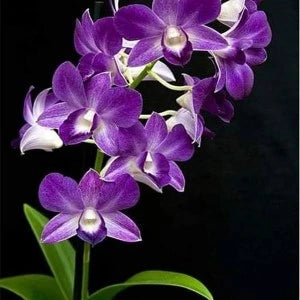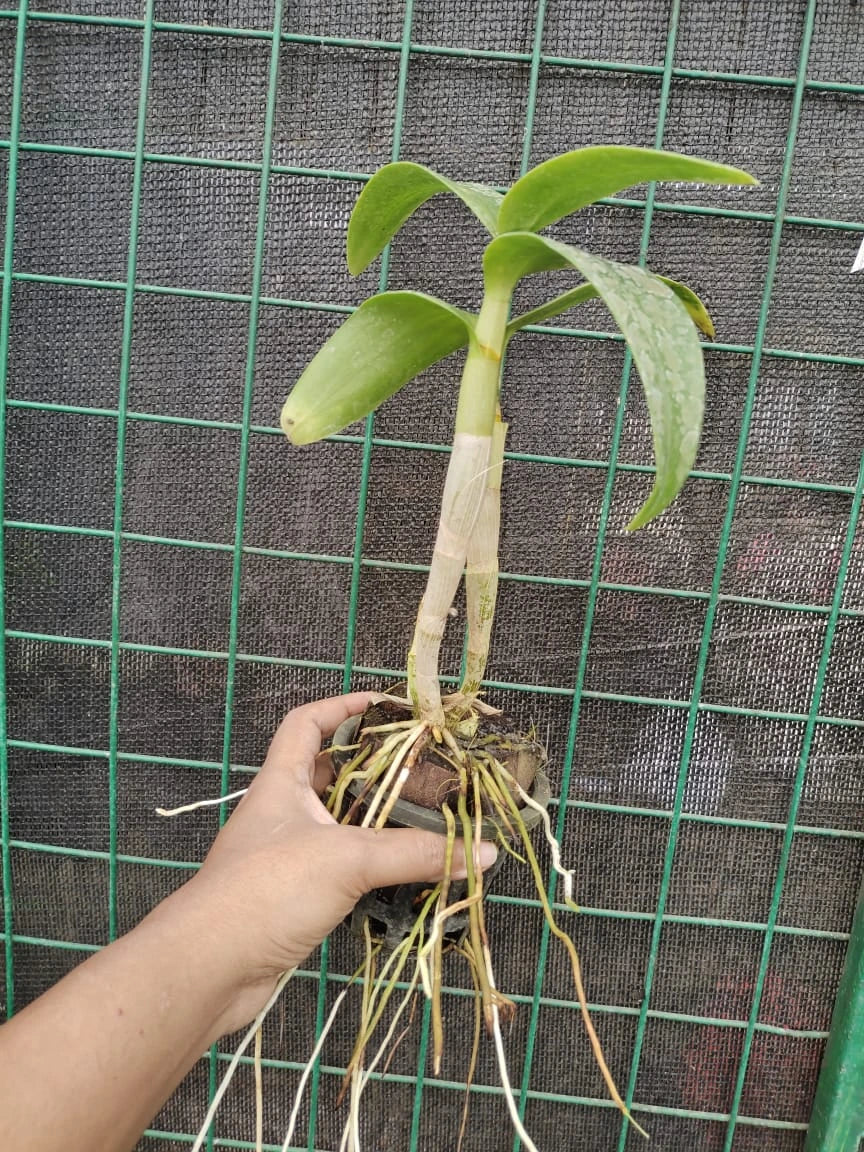

Product Description - Dendrobium Sweet Blue - Blooming Size
| Type | Hybrid |
| Fragrance | No |
| Flower colour | Purple |
| Flower size | 6cm – 8cm |
| Humidity | 60 % – 80% |
| Ideal growing temperature | Intermediate to warm |
| Light requirement | 70% indirect sunlight ideally |
| Plant size | Blooming size |
| Pot size | 10 cm |
| Media | Coconut husk |
| Blooming frequency |
Multiple times a year |
Note: The plants may or may not contain flowers or buds. There are chances that the buds/flowers could dry up due to transit stress even though we pack them with extreme care. The local climatic conditions and fertilization habits can affect the brightness & colour intensity of flowers. While we make every effort to match the actual colours of the flowers, the photographs may not be the exact representation, due to different monitor settings.
Shipping: This orchid ships for FREE. Please note that we might need up to 2-3 business days to properly dry and pack the plant and ship them.
Dendrobium Sweet Blue
The Dendrobium Sweet Blue is a stunning and highly sought-after orchid species that is sure to delight any plant enthusiast. Native to Southeast Asia, this orchid is known for its beautiful, large flowers that come in a range of colors including blue, purple, and white. The flowers of the Dendrobium Sweet Blue have a delicate fragrance that is sure to please the senses.
The Dendrobium Sweet Blue is an epiphytic orchid, meaning it grows on other plants or structures rather than in soil. It typically grows on tree branches or rocks in its natural habitat, and can be grown in a similar way in cultivation. It is a fast-growing species, with long, slender shoots that produce clusters of flowers throughout the year.
When it comes to caring for the Dendrobium Sweet Blue, it is important to provide it with the right amount of light. This species is a moderate light orchid, meaning it thrives in bright, indirect sunlight. It is important to provide it with enough light to encourage blooming, but be careful not to expose it to direct sunlight, as this can damage the leaves and flowers. A south-facing window with a sheer curtain or an east- or west-facing window with indirect light is a good location for this orchid. If you are unable to provide the plant with sufficient natural light, you can supplement with artificial lighting using fluorescent or LED grow lights.
Watering the Dendrobium Sweet Blue is important to keep the plant healthy and encourage blooming. It is best to water the plant thoroughly, allowing the water to drain through the pot, and then allow the top inch of the potting mix to dry out before watering again. This species is sensitive to excess moisture, so be careful not to over-water it. It is also a good idea to use tepid (lukewarm) water, as cold water can shock the plant. If you are unsure if the plant needs watering, you can check the moisture level of the potting mix by sticking your finger about an inch into the soil. If it feels dry, it is time to water. If it feels moist, wait a few more days before watering.
The Dendrobium Sweet Blue can be grown in a variety of potting mixes, including those specifically formulated for orchids or those made from materials such as bark, coconut coir, and perlite. It is important to choose a mix that provides good drainage and allows the roots to breathe. Repotting the plant every one to two years, or when the potting mix becomes compacted, will help ensure that it has enough space to grow and that the roots have access to fresh nutrients.
Fertilizing the Dendrobium Sweet Blue is important for promoting healthy growth and encouraging blooms. Use a balanced orchid fertilizer, such as one with a ratio of 20-20-20, and follow the instructions on the package for the correct dosage and frequency. It is also a good idea to flush the potting mix with clear water every few months to remove any excess fertilizer salts that may build up.
Pests and diseases: It is important to keep an eye out for pests and diseases that can affect your Dendrobium Sweet Blue orchid. Common pests that can affect these plants include mealybugs, scale insects, and thrips. If you notice any of these pests on your plant, use a gentle insecticide or try wiping the affected areas with a cotton swab dipped in rubbing alcohol. Diseases, such as root rot and fungal infections, can also be a problem for Dendrobium Sweet Blue orchids. To prevent these diseases, be sure to provide proper drainage
Caring Guide
The Dendrobium Sweet Blue is a stunning and highly sought-after orchid species native to Southeast Asia that is known for its beautiful, large flowers in shades of blue, purple, and white. These epiphytic plants are a joy to grow and care for, and with proper attention, they can provide a stunning display of fragrant flowers for years to come. Here is a comprehensive guide on how to care for your Dendrobium Sweet Blue orchid:
Light: The Dendrobium Sweet Blue is a moderate light orchid, meaning it thrives in bright, indirect sunlight. It is important to provide it with enough light to encourage blooming, but be careful not to expose it to direct sunlight, as this can damage the leaves and flowers. A south-facing window with a sheer curtain or an east- or west-facing window with indirect light is a good location for this orchid. If you are unable to provide the plant with sufficient natural light, you can supplement with artificial lighting using fluorescent or LED grow lights.
Air circulation: Proper air circulation is important for the Dendrobium Sweet Blue to prevent rot and disease and keep the plant healthy. A small fan placed near the plant can help provide the necessary air circulation.
Watering: Watering the Dendrobium Sweet Blue is important to keep the plant healthy and encourage blooming. It is best to water the plant thoroughly, allowing the water to drain through the pot, and then allow the top inch of the potting mix to dry out before watering again. This species is sensitive to excess moisture, so be careful not to over-water it. It is also a good idea to use tepid (lukewarm) water, as cold water can shock the plant. If you are unsure if the plant needs watering, you can check the moisture level of the potting mix by sticking your finger about an inch into the soil. If it feels dry, it is time to water. If it feels moist, wait a few more days before watering.
Potting mix: The Dendrobium Sweet Blue can be grown in a variety of potting mixes, including those specifically formulated for orchids or those made from materials such as bark, coconut coir, and perlite. It is important to choose a mix that provides good drainage and allows the roots to breathe. Repotting the plant every one to two years, or when the potting mix becomes compacted, will help ensure that it has enough space to grow and that the roots have access to fresh nutrients.
Fertilizing: Fertilizing the Dendrobium Sweet Blue is important for promoting healthy growth and encouraging blooms. Use a balanced orchid fertilizer, such as one with a ratio of 20-20-20, and follow the instructions on the package for the correct dosage and frequency. It is also a good idea to flush the potting mix with clear water every few months to remove any excess fertilizer salts that




